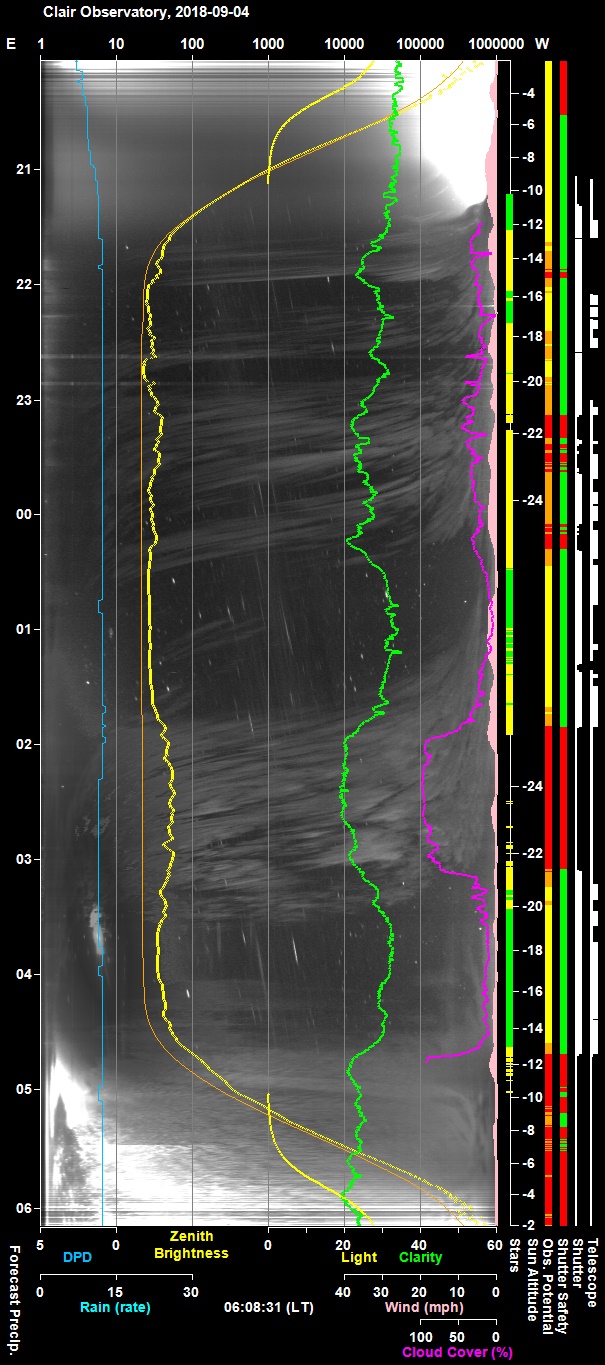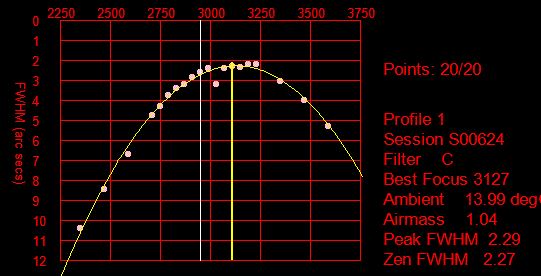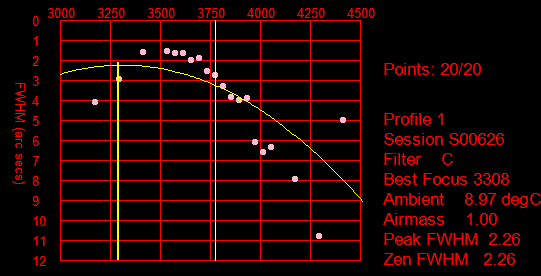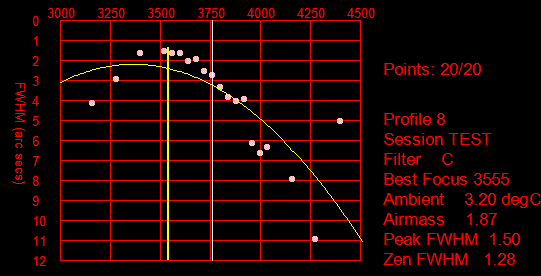David's Astronomy Pages
Notes - Session 626 (2018-09-04)
Notes
(S625)
Notes
Main
Home
Page
Notes
(S627)
David's Astronomy Pages
|
Notes (S625) |
Notes Main |
Home Page |
Notes (S627) |
Main aims
Equipment & Software
Highlights
Summary Plots & Logs
|
Observing Result (2018-09-04, S626) Observatory Unlocked at 20:50, Operations started at 21:02, Automated Mode from 21:05, Job Queue started at 21:26, Software interruptions at 21:36, 22:10, 22:17, 22:30, 22:35, 22:50 Session Suspended 22:08-22:12, 23:24-23:37, 00:08-00:20, 01:18-01:22, 01:51-03:06 due to Cloud. Session Closed at 04:42, Session crashed before Session Housekeeping & FInishing |
 |
| (Observation Status : Green=Completed, Yellow= Partially Completed, Red= Failed) |
|
Night Sky Summary Plot -
2018-09-04 Top axis: Sky Brightness at Zenith (in ADU/s) Lefthand axis: Local Time (hh LT). Righthand axis: Sun Altitude (degs) |
 |
Back to Top
Back to Top
The traditional Critical Focus Zone is the range of travel on the focuser
draw tube within which the defocus of a point source of light is smaller than
the first dark diffraction ring of the Airy disk. The traditional Critical Focus
Zone (denoted CFZ) is given by the formula
CFZ = 4.88
* Lambda * f 2
where
CFZ - Traditional Critical Focus Zone (micrometers)
4.88 -
constant (unitless)
Lambda - wavelength of light
(micrometers)
f - effective imaging system f/ratio (unitless)
For my 12” LX200GPS, operating at f/10.4, and using wavelength of 0.55 micrometers (550 nm, green) the critical focus zone is calculated to be 290 micrometers which is equivalent to 134 steps for my TCF-S Focuser (0.000085” per step), ie a zone that is +/-67 steps wide.
The basic foundation of the traditional Critical Focus Zone (CFZ) is that when at perfect focus, very small changes in focus do not degrade image quality in any significant way.
However research and
testing by GoldAstro has shown that the assertion that certain focus errors
are non-measurable must be revised. The "New Critical Focus Zone" (denoted NCFZ)
recognizes that all focus error is measurable. Instead of non-measurable focus
errors as in Critical Focus Zone, the New Critical Focus Zone uses a criteria of
whether focus has a negligible impact on image quality. NCFZ uses a
"tolerance" for focus error designated by the astroimager that is appropriate to
his/her needs. The New Critical Focus Zone is given by the formula
NCFZ = 0.00225 * ThetaFWHM
* sqrt (Tau) * A * f 2
where
NCFZ - New Critical Focus Zone (micrometers)
0.00225 - constant (micrometers per arc second per millimeter)
ThetaFWHM - total seeing (arc
seconds)
Tau - focus tolerance as a percentage of total
seeing (unitless)
A - telescope aperture (millimeters)
f - effective imaging system f/ratio (unitless)
[ see
New Critical Focus Zone
at http://www.goldastro.com/goldfocus/ncfz.php ]
For my 12” LX200GPS, operating at f/10.4, and with 1.5” FWHM total seeing and
a focus tolerance of 10% the critical focus zone is calculated to be 352
micrometers
(0.35mm) which is equivalent to 163 steps for my TCF-S Focuser (0.000085” per
step), i.e. a zone that is +/-81 focuser steps wide.
This CFZ changes
to +/- 54 steps for 1" seeing, +/-109 steps for 2" seeing, +/-136
steps for 2.5" seeing & +/- 163 steps for 3" seeing.
Back to Top
Reliable autofocussing is key component of successful unattended operation of
an observatory. Whilst my currently written autofocusing works well when
my eyes (and brain) are in attendance to either acknowledge the computer's best
focus position based on the data collected or quickly intervene to correct the
situation if an invalid/inappropriate focus position is selected or to cancel the
focusing operation if cloud develops and the star is lost.
Entry routine for performing autofocus is "PerformAutoFocusRun"
RunAutoPickFocusStar takes a full frame image and automatically select a
star )
objConsole.ShowFocusGraph shows the Focus
Graph
objConsole.MeasureFocusProfile measures the focus profile
and
objConsole.DrawGraphTab draws the Focus Graph
With a good dataset the existing Focus Algorithm works well (e.g.. 1st
Focus Profile below), but examples of where it doesn't work are shown in 2nd &
3rd profiles. In these cases only 1 or 2 'bad' data points are enough to completely
invalidate the calculation of Best Focus. A revised algorithm has been developed
(2018-09-06) which checks the result for consistency with 3 other measures of
Best Focus position (based on 'peak' FWHM position, and the centre position &
P50 position of the points lying within 1.5 arc sec of lowest FWHM
position).
|
1) Example of 'Good' Focus Profile Curve Fitting has worked well, 2018-09-01 ) |
 |
|
2) Examples of 'Bad' Focus Profiles Curve Fitting has been thrown significantly off by two 'bad' points (2018-08-30) |
 |
| Curve Fitting has been thrown off by a single 'bad' point (2018-09-04) |
 |
|
Focus Profile using new Focusing Algorithm Using same data as above profile, the new algorithm (2018-09-06) recognises the discrepancy between the Curve Fitted Result and an Alternate Result that uses the just the highest FWHM values and elects to use the Alternate Value at Best Focus Position in this case |
 |
|
Focus Profile using new Focusing Algorithm (annotated with selected focus star images and CRZ) |
 |
Back to Top
Working on a new routine for taking Sky Flats
- Button 'Take Dusk Flats' (Take Dawn Flats will be added at a later
date)
- File defining the filter/bin sets to be acquired by sky flats routine
is hard coded as AutoSkyFlats.txt (this will be changeable at a later date) .
The order of rows in the file defines the order in which flats are to be
acquired if taken at dusk. (The order will be automatically reversed for Dawn
Flats). Filters for wavelengths where the ST-10 CCD is less sensitive (eg.
B) or narrow band filters should be given first, C filter should be given
last.
- No. of frames for each filter/bin set is hard-coded as 15 (this will be changeable at a later date)
- Routine objconsole.RunTakeDuskFlats
- This calls the routine TakeAutoSkyFlatsNew(1, 0) '
where 1 (Dusk), 0 (Not Auto)
- After reading the AutoSkyFlats.txt a
Loop calls TakeAutoSkyFlatsSetNew routine for each filter/bin set
CalcFlatSpot calculates Flat Spot Az/Alt based on current Sun
Location
SlewToFlatSpot slews the scope to current Flat Spot
Back to Top
| This Web Page: | Notes - Session 626 (2018-09-04) |
| Last Updated : | 2024-02-20 |
| Site Owner : | David Richards |
| Home Page : | David's Astronomy Web Site |